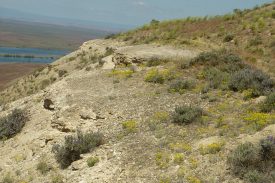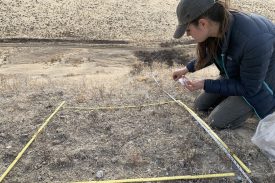Seeding for the Future
Last fall, the Rare Plant Care and Conservation Program (Rare Care) initiated a new study to investigate whether direct seeding is a viable alternative for establishing new populations of White Bluffs bladder-pod (Physaria douglasii ssp. tuplashensis). The only known population of this plant occurs at the Hanford Reach National Monument. It grows on the white bluffs along the east side of the Columbia River on a white cemented alkaline substrate rich in calcium.

White Bluffs bladderpod was listed as threatened under the Endangered Species Act in 2013. Slumping of the bluffs was identified as one of the main threats to the plant, resulting in the loss of plants and suitable habitat. Slumping is a natural process, but it has been made worse by the presence of groundwater originating from irrigation of fields and water impoundments on lands above the bluffs. Therefore, a strategy for this species’ recovery will be to increase its presence on more stable sections of the bluffs where the white substrate is exposed.
Recovering endangered species often requires augmenting existing populations and establishing new populations to reduce the risk of extinction. To be success successful, reintroductions require careful planning and experimentation to determine what sites are suitable for new populations, whether plants or seeds should be used, how large of a population is needed to establish viable populations, and other considerations.
Practitioners commonly use plants grown in a nursery for reintroductions. Reintroductions with plants have a higher establishment rate per propagule (any material that can be used to propagate a plant) than directly sown seeds; therefore, less material is needed. However, growing plants in a nursery and caring for them during the first several seasons is time intensive and expensive. Therefore, sowing seeds becomes an attractive alternative if sufficient seeds are available.

This may be the case with the White Bluffs bladderpod. This short-lived perennial starts flowering in its first or second year and produces abundant seed, making it a good species to attempt direct seeding. However, its environment may make seeding challenging. The steep exposed white soils of the bluffs form a hardened layer that seeds can easily roll off. Seasonal rainfall is very low and episodic, leading to years of low recruitment (when new individuals grow, adding to an existing population). Winds also pose a challenge. Prevailing winds arise from the river and accelerate over the crest of the bluffs, strewing material out onto the sagebrush plains.
Rare Care’s seeding experiments will tackle these thorny issues by testing different techniques, timing and locations for direct seeding. We will seed 300 seeds into a series of 1-square-meter plots in different seasons using different site preparations. Plots will be located along transects in three locations: one adjacent to and within the northern extent of the natural population, and two located further north along the bluffs where the species is not known to occur.
We will track recruitment over several years and consider how physical site characteristics, site preparation, and cover of associated species affect germination and establishment. We will also consider how climatic variation during the experimental period may influence the success of the seedings. We hope that the results will shed light into whether seeding is a viable option for this species, how it might be accomplished, and whether the bluffs north of the natural population are suitable for this species.